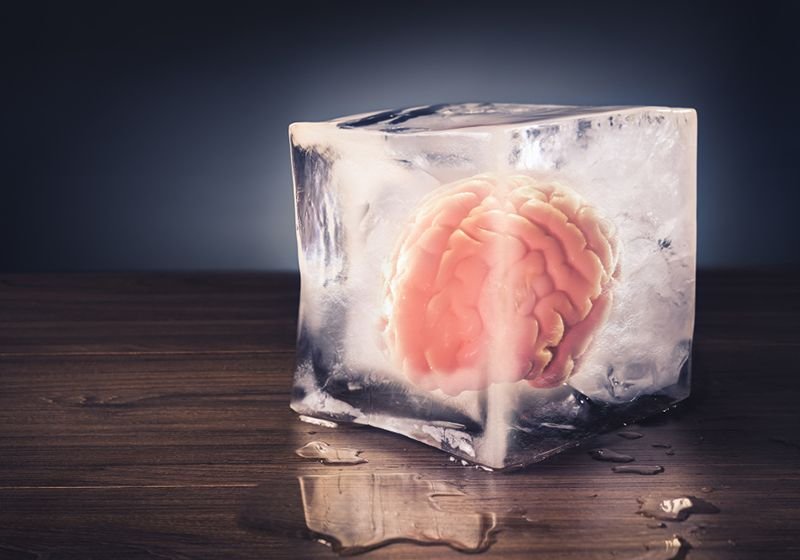Both winter-loving people who enjoy skiing and snowball fights, and people simply trying to endure their stints outside, have felt the chilly air hit their faces. They’ve wondered if that iciness influenced the brain.
The good news is that the brain is exceptional at maintaining its temperature at a cozy 37°C. “For the average human out skiing in cold weather, the brain temperature is protected,” said Mel Robertson, professor emeritus and neuroscientist at Queen’s University. While the brain triggers various mechanisms to protect the body when the external temperature drops, long-term exposure to cold can cause serious brain damage.
When the mercury drops, the cold-sensing nerves in the skin send electrical signals to a specific region of the hypothalamus called the preoptic area, which regulates body temperature.1,2 “This thermostat will send signals back to the body and tell the body that you need to thermoregulate,” said Elena Gracheva, a neuroscientist at Yale University. The thermostat increases body temperature by regulating constriction of blood vessels, stimulating muscle twitches (shivering), and producing heat by burning more fuel.2,3
“We burn a lot of our calories per day maintaining our body temperatures,” said Neeraj Lal, a neuroscientist at the Scripps Research Institute. To investigate how cold triggers hunger signals in the brain to replenish these calories, Lal and his team studied the influence of cold on mouse brains. They noted that a section of the mouse thalamus called the xiphoid nucleus produced high levels of c-Fos, a protein used as a marker of neural activity, as temperatures dropped. Activity in the xiphoid nucleus remained high even as other brain areas such as the cortex started to shut down, which can happen when the core temperature drops.4

To investigate the role of xiphoid nucleus, Lal and his colleagues engineered receptors for neurotransmitters in the xiphoid nucleus that were sensitive to a specific drug so that they could artificially stimulate the xiphoid nucleus in the mouse brain. When the xiphoid nucleus was stimulated in cold temperatures, the mice ate more. When they engineered receptors to artificially suppress neural signals in the xiphoid nucleus, the mice ate less in cold temperatures. When both experiments were carried out in warm temperatures, the amount of food the mice ate did not change significantly, suggesting that the xiphoid nucleus controls appetite in response to cold.
Although the brain strives to maintain a stable body temperature through these mechanisms, long-term exposure to cold can cause serious damage. Even a 2°C drop in the core body temperature can cause hypothermia. At this point, the effects of cold on the brain are most apparent.
“At 18°C, we’ll have a massive leak in our blood-brain barrier, and the brain is not protected anymore from the normal junk we produce,” Gracheva said. The resulting flood of toxins through the hole-ridden blood-brain barrier can lower the brain’s ability to function.
At extreme cold temperatures, the ion channel proteins also malfunction. Consequently, a higher number of potassium ions can leave the neuron, and when that happens, the neuron will shut down, but not before triggering the spread of this ion imbalance, according to Robertson.5 “You can’t have neural function when extracellular potassium is that high, so all the neurons enter an off state,” Robertson said. As a result, the neural activity in parts of the brain shut down after exposure to extreme cold. “Our neurons and heart will die first during hypothermia because these ion transporters cannot function at lower temperatures,” said Gracheva.
Amazingly, studies have found that humans exposed to cold temperatures for long periods of time can survive and show normal brain activity, so Robertson thinks that the brain might shut down to protect itself from further damage.6 Still, if you’re heading outside in the remaining weeks of winter, it would still be best to avoid finding out by bundling up and letting your brain’s thermostat take care of the rest.
References
- Nakamura K, Morrison SF. Preoptic mechanism for cold-defensive responses to skin cooling. J Physiol. 2008;586(10):2611-2620.
- Nakamura K, Morrison SF. Central efferent pathways for cold-defensive and febrile shivering. J Physiol. 2008;586(10):2611-2620.
- Kenny GP, Flouris SF. The human thermoregulatory system and its response to thermal stress. Protective Clothing. 2014;319-365.
- Lal NK, et al. Xiphoid nucleus of the midline thalamus controls cold-induced food seeking. Nature. 2023;621(7977):138-145.
- Robertson RM, et al. Neural shutdown under stress: an evolutionary perspective on spreading depolarization. J Neurophysiol. 2020;123(3):885-895.
- Hilmo J, et al. Nobody is dead until warm and dead: Prolonged resuscitation is warranted in arrested hypothermic victims also in remote areas–A retrospective study from northern Norway. Resuscitation. 2014;85(9):1204-1211.










